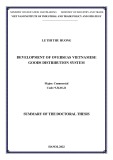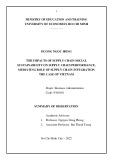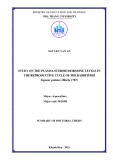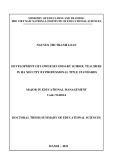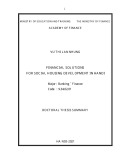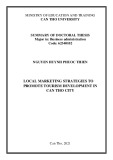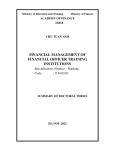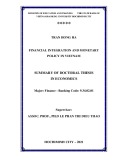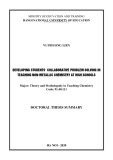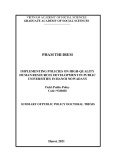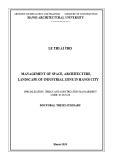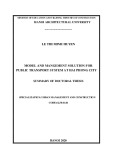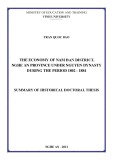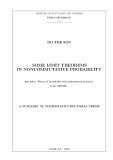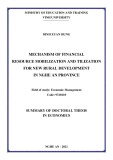MINISTRY OF EDUCATION AND
TRAINING
VIETNAM ACADEMY OF SCIENCE AND TECHNOLOGY
GRADUATE UNIVERSITY SCIENCE AND TECHNOLOGY
PHAM THE CUONG
STUDY ON THE DIVERSITY AND DISTRIBUTION PATTERNS
OF AMPHIBIANS (AMPHIBIA) IN KARST FORESTS OF THE NORTH VIETNAM AND CONSERVATION MEASURES
Research field: Zoology Code: 62.42.01.03
SUMMARY OF BIOLOGY DOCTORAL THESIS
HA NOI – 2018
This dissertation is submitted to the Committee of the Graduate University of Science and Technology
Supervisors: 1. Dr. Nguyen Quang Truong
2. Dr. Le Duc Minh
Referee 1: Ass. Prof. Dr. Le Nguyen Ngat Referee 2: Ass. Prof. Dr. Hoang Ngoc Thao Referee 3: Dr. Hoang Van Ngoc
The research has been carried out at the Graduate University of Science and Technology Date of Oral Presentation:……,…../……../2018
Copy of this dissertation is available: National Library of Viet Nam Graduate University of Science and Technology
INTRODUCTION 1. The necessity of the research
Vietnam is recognized as one of the countries with a high level of biodiversity in the world (Conservation International 2014). In terms of amphibian diversity (Class Amphibia), the species number recorded from Vietnam has been rapidly increased in recent decades: from 82 species in 1996 to 162 species in 2005 and up to 176 species in 2009 and the current species number is ca. 230 (Nguyen & Ho 1996, Nguyen et al. 2005, 2009, Frost 2017).
Karst ecosystem is considered as a natural laboratory for taxonomic, ecological, evolutionary and biogeographical research (Clements et al. 2006). Karst forests provide a variety of distinct microhabitats like “isolated islands” and are noted for their high levels of endemism (Clements et al. 2006). In Vietnam, limestone forests are extensive in the northeastern, northwestern regions and northern Truong Son Range (Sterling et al. 2006).
However, limestone forest is a sensitive ecosystem to the human impacts and it is very difficult to restore. Limestone in Vietnam has been exploited for infrastructure and economic development, for example, quarrying for road construction, and cement industry. Moreover, the fauna in karst forests is threatened by decline because of forest destruction, overexploitation, tourism development and climate change, in particular, the poikilotherm like amphibians (Sterling et al. 2006).
The research entitled "Study on the diversity and distribution patterns of amphibians (Amphibia) in karst ecosystem of the North Vietnam and conservation measures” aims to assess the diversity of amphibians in limestone forests of northern Vietnam with special focus on two group complexes of anuran frogs, Limnonectes and Odorrana, in Vietnam. In addition, recommendations for conservation measures are also provided. 2. Objectives - To assess the diversity of amphibians in some selected limestone forests of northern Vietnam; - To review taxonomic and phylogenetic relationships of two genus complexes, Limnonectes and Odorrana, in Vietnam;
10
- To assess conservation potential and threats to the amphibian
fauna and to provide recommendations for conservation. 3. Contents
Task 1: Inventory of the species diversity of amphibians in some karst forests in northern Vietnam: Hoa Binh Province in the northwestern region, Cao Bang and Ha Giang provinces in the northeastern region and Cat Ba Island, an offshore island in the Gulf of Tonkin. This research also focuses on the discovery of new species and new country records.
Task 2: Evaluating distribution patterns of amphibian species across altitudinal gradient (from 0 to 1300 m), habitat types and life modes (on the tree, on the ground, and associated with water).
Task 3: Evaluating biogeographic relationships of amphibian fauna amongstudy sites, between mainland and offshore islands, and between northeastern and northwestern regions to verify the evolutionary barrier of the Red River.
Task 4: Evaluating taxonomy and phylogenetic relationships of two the genus complexes, Odorrana and Limnonectes, based on morphological comparison and molecular analyses.
Task 5: Assessment of conservation potential based on the following criteria: species diversity, number of endemic and threatened species, possibility of population restoration. Evaluation of threats to the amphibian populations and provide recommendations for conservation measure. 4. Scientific and conservation significances
Scientific significance: The research provides updated data about the diversity of amphibians in the karst forests of northern Vietnam. The research also provides novel data on taxonomy and phylogenetic relationships of Limnonectes and Odorrana from Vietnam.
Conservation significance: The research provides baseline data for biodiversity conservation planning and management in northern Vietnam. 5. New findings
A total 65 species of amphibans were recorded in karst forests of the North Vietnam, comprising 44 species recored from Ngoc Son-Ngo
11
Luong NR, 32 species recorded from Hang Kia-Pa Co NR, 33 species recorded from Bac Me NR, 21 species recorded from Ha Lang District, and 23 species recorded from Cat Ba NP.
New species: Three new species were described as new for science, Odorrana mutschmanni from Cao Bang Province, Theloderma annae and Rhacophorus hoabinhensis from Hoa Binh Province.
New records: Three species, Leptolalax minimus, Odorrana hainanensis, and O. lipuensis, were recorded for the first time from Vietnam and some other new provincial records from northern Vietnam: One species from Cao Bang Province; two species from Ha Giang Province; three species from Hai Phong city; and five species from Hoa Binh Province.
the amphibian fauna of that of
Biogeographic relationships: Based on the list of amphibian species the recorded from northern Vietnam, northeastern region was distinctly separated from the northwestern region (Similarity Index = 0.6087). Moreover, the amphibian fauna of the karst forests in mainland also differs from that of the offshore islands (Similarity Index = 0.4706).
Distribution patterns: Most of amphibian species were recorded at elevations below 800 m (58 species), whereas 34 species were found at elevations above 800 m. In terms of habitat types, most of amphibian species were recorded in the undisturbed natural forests (58 species), while the species number recorded in the disturbed forest was 33 species and agricultural and residential areas was 16 species. The highest number of record species were found on the ground (42 species).
In this study, we also provide taxonomic review of two poorly known genera of amphibians, Limnonectes (8 species) and Odorrana (25 species), based on morphological and molecular data with descriptions of two new species for science and three new country records for Vietnam. Phylogenetic relationships of these genera were also discussed with remarks on some species complexes.
In addition, we evaluated the threats to the amphibian fauna and provided some recommendations for conservation in northern Vietnam.
12
Chapter 1 LITERATURE REVIEW
1.1. Overview of amphibian research in region
Currently, a total 7.697 species of amphibians was recorded in the world (Frost 2017). In the neigboring countries, 432 species have been recorded from China; 152 species from Lao and 79 species from Cambodia (Frost 2017).
In terms of conservation concern, Stuart et al. (2004) stated that 168 species of amphibian were extinction and at least 2,500 species are under threatened in the last 20 years (1984-2004).
1.2. Overview of amphibian research in Vietnam 1.2.1. Faunistic inventory and new discoveies
Bourret (1942) reported 171 species and subspecies of amphibians in Indochina (Vietnam, Laos, Cambodia). Nguyen and Ho (1996) published a checklist of reptiles and amphibians of Vietnam with 82 recorded species of amphibians. Nguyen et al. (2005) listed 162 species of amphibians. In the recent book, Nguyen et al. (2009) recorded a total of 176 species of amphibians from Vietnam. Since 2010 more than 40 new species of amphibians have been described from Vietnam (Forst 2017).
A number of studies on amphibians were conducted in the Northeast, Northwest, Central, Central Highlands, Southern and some offshore islands of Vietnam. 1.2.2. Research on biology and ecology
Research on biological and ecological characters of amphibians focused on few species that were kept in captivity, the widespread species or endemic to Vietnam: Duttaphrynus melanostictus, rugulosus, Limnonectes bannaensis, Hylarana Hoplobatrachus maosonensis, Quasipaa verrucospinosa, Polypedates mutus, Paramesotriton deloustali. 1.2.3. Research on tadpoles and bioacoustics
Descriptions of the tadpoles of the following species were mentioned in previous studies (Hendrix et al. 2007, Gawor et a. 2009, Wildenhues et al. 2010, Rauhaus et al. 2012, Pham et al. 2015): Rhacophorus annamensis, Hynarana nigrovittata, Rhacophorus
13
maximus, Theloderma corticale, Amolops cremnobatus. Le Thi Quy (2015) described the tadpoles of 21 amphibian species from Bach Ma National Park, Thua Thien Hue Province.
In addition, the bioacoustic analysis is a useful approach to study biology and taxonomy of amphibians. Le Trung Dung (2016) described the biaocoustics of 11 amphibians species. 1.2.4. Research on phylogenetic relationships
Frost et al. (2006) provided a comprehensive phylogenetic tree of amphibian species of the world. Li et al. (2008, 2009), Biju et al. (2010), Orlov et al. (2012), Kuraishi et al. (2012), Li et al. (2012), Yu et al. (2010, 2013), Nguyen et al. (2015), Poyarkov et al. (2015) studied on taxonomy and phylogenetic relationships of various groups of Rhacophoridae. 1.2.5. Research on pathology and conservation issues
that Rowley et al. (2013), Nguyen et al. (2013), Martel et al. (2014), Laking et al. (2017) and Nguyen et al. (2017) have identified a number infected with Batrachochytrium of amphibian populations dendrobatidis and B. salamandrivorans.
Rowley et al. (2010, 2016) assessed threats to the populations of amphibians in Southeast Asia, including Vietnam. Key impacts include habitat loss, overexploitation for food, medicinal and pet trade. 1.2.6. Research on amphibians in northern Vietnam
Although numerous field excursions have been conducted in northern Vietnam, most of surveys were conducted in evergreen forests such as Tay Yen Tu, Tay Con Linh, Phia Oac-Phia Den, Hoang Lien, Muong Nhe, Sop Cop, and Copia nature reserves (Hecht et al. 2013, Bain & Nguyen 2004, Nguyen Thien Tao 2009, Orlov et al. 2001, Le Trung Dung 2016, Pham Van Anh 2016). Research in limestone karst ecosystems are still limited with descriptions of new species, namely Tylototrion ziegleri from Cao Bang and Ha Giang provinces, Liuixalus calcarius and Philautus catbaensis from Cat Ba Island (Nishikawa et al. 2013, Milto et al. 2013). 1.2.7. Research on Limnonectes and Odorrana in Vietnam
Genus Limnonectes: Limnonectes is one of the most diverse groups of amphibians to date with 68 currently recognized species and
14
16 of which have been described in the last ten years (Frost 2017). According to Nguyen et al. (2009), five species of the genus Limnonectes are currently recorded from Vietnam. However, some taxonomic changes have been published in recent years. Due to their morphological similarity, species that were previously thought to be widespread are now being recognized as complexes of species with much narrower distributions
Genus Odorrana: Odorrana is one of the most diverse groups of amphibians to date with 58 currently recognized species, more than 20 of which have been described in the last ten years (Frost 2017). Due to morphological similarity in the genus, species that were formally thought to be widespread are now being recognized as complexes of species with much narrower distributions. Further study on taxonomic and genetic relationships should be continued. 1.3. Natural conditions of the study area 1.3.1. Natural conditions of North Vietnam
The North Vietnam bordered by China’s Guangxi Province to the northeast and Yunnan Province to the northwest, and by Laos along its western border (Sterling et al. 2006).
Limestone kart forests: Most of the limestone mountain area in Vietnam is distributed in northern Viet Nam, partly in Quang Binh province. In the Gulf of Tonkin, there are thousands of limestone islands in Ha Long Bay next to each other with Cat Ba Island as the center (Sterling et al. 2006).
Vegetation: The dominant forest type in northern Vietnam is evergreen, including both broad-leaved and coniferous plants, with pockets of semi-evergreen forest. Coastal mangrove formations and forests growing on limestone are also important elements of the north’s natural landscape diversity (Sterling et al. 2006).
Fauna: Northern Vietnam’s animal communities are a mixture of tropical and subtropical species, many of which are unique to the northern third of the country. Within the region, the Red River may be an effective barrier to movement (or coincide with one) for some groups, such as amphibians and reptiles, resulting in different species and communities in the northeast and northwest (Sterling et al. 2006).
15
1.3.2. Natural conditions of survey sites
Field surveys were conducted in the limestone forestin northern Vietnam.
Northwest: Ngoc Son-Ngo Luong Nature Reserve (Hoa Binh Province): This NR is located in Tan Lac and Lac Son districts with a total area of 19.254 ha. The area is characterized by limestone mountains, with steep terrain and rugged terrain. Between the limestone mountains there are several flat valleys running in the north-west direction. The altitude ranges from 100-1.065 m (Birdlife International 2004).
Hang Kia-Pa Co Nature Reserve (Hoa Binh Province): Hang Kia-Pa Co Nature Reserve is located in Mai Chau District with a total area of 5.257 ha. There are many high and pointed limestone blocks, the highest peak of which is 1.536m in the Northwest of the area, the height decreasing to the East. Most of the nature reserve stands at over 500 m (Birdlife International 2004).
Northeast: Bac Me Nature Reserve (Ha Giang Province): This NR is located in Bac Me District with a total area of 9.042 ha,. Bac Me Nature Reserve is located in the depression of the Gam River to the south-east of Ha Giang Province, with steep terrain and strong splinters with many peaks above 1000 m along the Song Gam gulf (Biodiversity Report Bac Me Nature Reserve 2009).
Ha Lang Forest (Cao Bang Province): Ha Lang District has a limestone karst topography that occupies most of the area, at an altitude of 100-750 m above sea level. According to the biodiversity conservation planning of Cao Bang Province, a nature reserve will be established in this district with an area of 7.343 ha (Decree No. 697/QĐ-UBND).
this protected area the area of Cat Ba National Park: Cat Ba is the largest island of the Cat Ba Archipelago with a total area of 26.241 ha. Cat Ba National Park is located in the limestone archipelago of hundreds of large and small islands at the height of 100-150 m, the highest point is Cao Vong peak is 16.196 ha 331m and (www.vuonquocgiacatba.com.vn).
16
CHAPTER 2. MATERIALS AND METHODS 2.1. Field survey and study sites
Fifteen field surveys with 119 days were conducted from 2014 to 2017. Survey sites: Cat Ba National Park (Hai Phong City), Ha Lang Disstrict (Cao Bang Province), Bac Me Nature Reserve (Ha Giang Province), Hang Kia-Pa Co and Ngoc Son-Ngo Luong nature reserves (Hoa Binh Province).
Sampling of Limnonectes and Odorrana: Twenty field surveys with 200 days were conducted in more than twenty provinces in Vietnam from 2014 to 2017.
Molecular analysis was carried out at the Institute of Ecology and Biological Resources and Vietnam National Museum of Nature, and Hanoi University of Science. 2.2. Methods 2.2.1. Sampling Excursions were carried out during the day and at night in different habitat types.
Survey transects were set up along the streams, pools, small ponds or along the forest paths, under the leaf litter or on the tree branches, we thus also survey the forest near the cave entrances and cliffs. 2.2.2 Laboratory work 2.2.2.1. Morphological examination
Taxonomic identification: Morphological comparisons were made with the voucher specimens which are deposited in the collections of the Institute of Ecology and Biological Resources and Vietnam National Museum of Nature. For taxonomic identification, we used the following documents: Bourret (1942), Bain et al. (2003), Ohler et al. (2011), Orlov et al. (2003, 2006, 2012), Suwannapoom et al. (2016), Taylor (1962), and othe related documents that were cited in each species account. Species names followed Nguyen et al. (2009), Frost (2017) and recently published papers. 2.2.2.2. Molecular analysis
A fragment of mitochondrial gene (cytochrome b, 12S, 16S) was sequenced to investigate phylogenetic relationships of all species of the genus Limnonectes and Odorrana in Vietnam.
17
The sequences were aligned using ClustalX v2.1 (Thompson et al. 1997), selected the optimal model using Modeltest v3.7 (Posada and Crandal 1998), analyzed using Bayesian inference (BI) as implemented in Mr.Bayes v3.1.2 (Ronquist et al. 2012).
We used BI and maximum-likelihood (ML) approaches to reconstruct the mitochondrial gene tree (matrilineal genealogy). The analyses used a concatenation of COI and 16S rRNA sequences. 2.2.3. Distribution patterns
Habitat: Species composition were assessed in different habitat types (agricultural and residential areas, disturbed natural forests, undisturbed natural forests). Altitudinal gradient: We compared the species composition of amphibians between elevations below 800 m and above 800 m.
Life modes: Species composition of amphibians was evaluated based on three life modes: on the trees, on the ground, and associated with water. 2.2.4. Conservation status
Conservation status of threatened species was referred to the Vietnam Red Data Book (2007); IUCN Red List (2017); CITES appendices (2017); the Governmental Decree No. 32/2006/ND-CP; and the Governmental Decree No. 160/2013/ND-CP. The endemic species of Vietnam are species that currenly known only from Vietnam. 2.2.5. Statistic analysis Statistic analyses were performed with the softwware PAST
Statistics (Hammer et al. 2001) 2.2.6. Conservation issues - Evaluation of threats to amphibians, for example habitat loss and
degradation and overharvesting.
habitat restoration, protection control
- Providing recommendations for conservation with the following aspects: of and hunting/overharevesting, development of breeding program, and awareness campaign. 2.3. Materials A total of 524 specimens of amphibians were collected in karst forests of the North Vietnam for morphorlogical analysis.
18
A total of 148 specimens of Limnonectes and 232 specimens of Odorrana were collected in Vietnam for morphorlogical analysis.
A total of 150 tissue samples, consisting of 46 tissue samples of Limnonectes, 74 tissue samples of Odorrana, and 30 tissue samples of Liuixalus, Rhacophus, and Theloderma, were use for molecular analysis.
Chapter 3 RESULTS AND DISCUSSION
3.1. Species composition of amphibians 3.1.1. List of recorded species A collection of 524 specimens of amphibians was collected from
different survey sites in the research areas.
Species composition: A total of 65 species belonging to 30 genera, 8 families, 3 orders, comprising 44 species (26 genera, 7 families, 2 orders) recorded from Ngoc Son-Ngo Luong NR, 32 species (21 genera, 6 families, 1 orders) recorded from Hang Kia-Pa Co NR, 33 species (20 genera, 7 families, 2 orders) recorded from Bac Me NR, 21 species (12 genera, 5 families, 1 orders) recorded from Ha Lang District, and 23 species (15 genera, 5 families, 1 orders) recorded from Cat Ba NP (Table 3.1) In terms of species diversity, Rhacophoridae is the most diverse
family with 9 recorded genera and 21 recorded species (Figure 3.1).
Figure 3.1. Species diversity of amphibian families
19
Table 3.1. List of amphibians recorded in the research areas
Vietnamese name
Scientific name
N o
5
1. 2.
Bộ Không đuôi Họ Cóc Cóc nhà Cóc rừng Họ Cóc bùn Cóc mày sa pa Cóc mày nhỏ Cóc mày Cóc mày đêm
3. 4. 5. 6.
Study sites 4 3 2 1 + + + + + + + + + + + + +
7. 8. 9.
Cóc núi Cóc núi miệng nhỏ Cóc mắt bên Họ Nhái bầu Cóc đốm Ếch ương thường Nhái bầu bec-mo Nhái bầu bút-lơ Nhái bầu hoa Nhái bầu
10. 11. 12. 13. 14. 15.
+ + + + + + + + + + + + + + + + + + +
Anura Bufonidae Gray, 1825 Duttaphrynus melanostictus (Schneider, 1799) Ingerophrynus galeatus (Günther, 1864) Megophryidae Bonaparte, 1850 Leptobrachium chapaense (Bourret, 1937) Leptolalax minimus (Taylor, 1962) (**) Leptolalax pelodytoides (Boulenger, 1893) Leptolalax nyx Ohler, Wollenberg, Grosjean, Hendrix, Vences, Ziegler & Dubois, 2011 Ophryophryne pachyproctus Kou, 1985 Ophyryophryne microstoma Boulenger, 1903 Megophrys major (Boulenger, 1908) Microhylidae Günther, 1858 Kalophrynus interlineatus (Blyth, 1855) Kaloula pulchra Gray, 1831 Microhyla berdmorei (Blyth, 1856) Microhyla butleri Boulenger, 1900 Microhyla fissipes Boulenger, 1884(*) Microhyla mukhlesuri Hasan, Islam, Kuramoto, Kurabayashi & Sumida, 2014
16. 17. 18.
Microhyla pulchra (Hallowell, 1861) Micryletta inornata (Boulenger, 1890) Dicroglossidae Anderson, 1871
+ + + + + + + + + + +
19. 20. 21. 22. 23. 24. 25. 26. 27.
Nhái bầu hây-môn Microhyla heymonsi Vogt, 1911 Nhái bầu vân Nhái bầu trơn Họ Ếch nhái chính thức Fejervarya limnocharis (Gravenhost, 1829) Ngoé Hoplobatrachus rugulosus (Wiegmann, 1834) Ếch đồng Limnonectes bannaensis Ye, Fei & Jiang, 2007 Ếch nhẽo ban-na Limnonectes limborgi (Sclater, 1892)(*) Ếch lim-boc Quasipaa delacouri (Angel, 1928) Ếch vạch Quasipaa boulengeri (Gunther,1899) Ếch gai bau-len-go Quasipaa verrucospinosa (Bourret, 1937) Ếch gai sần Cóc nước sần Occidozyga lima (Gravenhorst, 1829) Cóc nước mac-ten Occidozyga martensii (Peters, 1867) Họ Ếch nhái Ếch bám đá Chàng hiu Chàng đài bắc Ếch suối Ếch xanh Ếch bám đá hoa
28. 29. 30. 31. 32. 33.
+ + + + + + + + + + + + + + + + + + + + + + + + + + + + + + + + + + + + +
+
Ếch hải nam Ếch li-pu
34. 35.
+ +
Ranidae Rafinesque, 1814 Amolops ricketti (Boulenger, 1899) Hylarana macrodactyla (Günther, 1858)(*) Hylarana taipehensis (Van Denburgh, 1909) Hylarana sp. Odorrana chloronota (Günther, 1876) Odorrana geminata Bain, Stuart, Nguyen, Che & Rao, 2009 Odorrana hainanensis Fei, Ye & Li, 2001(**) Odorrana lipuensis Mo, Chen, Wu, Zhang & Zhou, 2015(**)
36.
Ếch đá mut-x-man Odorrana mutschmanni Pham, Nguyen, Le,
+
37. 38. 39. 40. 41.
Ếch mõm dài Ếch ti-an-nan Hiu hiu Chẫu chuộc Chàng mẫu sơn
Bonkowski & Ziegler, 2016(***) Odorrana nasica (Boulenger, 1903) Odorrana tiannanensis (Yang & Li, 1980) Rana johnsi Smith, 1921 Sylvirana guentheri (Boulenger, 1882) Sylvirana maosonensis (Bourret, 1937)
+ + + + + + + + + + + + +
20
42.
43. 44.
Ếch suối meng-la Họ Ếch cây Nhái cây sọc Nhái cây wa-za
+ + + +
+
+
45.
Nhái cây quang
+ +
46.
Nhái cây nhỏ đá vôi
+
47. 48.
Nhái cây tay-lo Nhái cây cát bà
+ + + + + +
49. 50. 51. 52. 53. 54. 55.
Ếch cây đầu to Ếch cây mi-an-ma Nhái cây tí hon Ếch cây xanh đốm Ếch cây phê Ếch cây ki-ô Ếch cây hòa bình
+ + + + + + + + + + + + + + + + + + + +
56. 57. 58. 59.
Ếch cây lớn Ếch cây oóc-lốp Ếch cây màng bơi đỏ Ếch cây sần an-na
+
60. 61. 62. 63.
Ếch cây sần đốm trắng Ếch cây sần bắc bộ Ếch cây sần go-don Ếch cây sần đỏ
+ + + + + + + + + + + + + + + + + +
Bộ Có đuôi Họ cá cóc Cá cóc zig-lơ
64.
+
Bộ Không chân Họ Ếch giun Ếch giun ban-na
65.
Sylvirana menglaensis (Fei, Ye & Xie, 2008)(*) Rhacophoridae Hoffman, 1932 Feihyla vittata (Boulenger, 1887) Gracixalus waza Nguyen, Le, Pham, Nguyen, Bonkowski & Ziegler, “2012” 2013 Gracixalus quangi Rowley, Dau, Nguyen, Cao & Nguyen, 2011(*) Liuixalus calcarius Milto, Poyarkov, Orlov & Nguyen, 2013 Kurixalus bisacculus (Taylor, 1962) Philautus catbaensis Milto, Poyarkov, Orlov & Nguyen, 2013 Polypedates megacephalus Hallowell, 1861 Polypedates mutus (Smith, 1940) Raorchestes parvulus (Boulenger, 1893) Rhacophorus dennysi Blanford, 1881 Rhacophorus feae (Boulenger, 1893) Rhacophorus kio Ohler & Delorme, 2006 Rhacophorus hoabinhensis Nguyen, Pham, Nguyen, Eto & Ziegler, 2017(***) Rhacophorus maximus Günther, 1858(*) Rhacophorus orlovi Ziegler & Kohler, 2001 Rhacophorus rhodopus Liu & Hu, 1962(*) Thelodema annae Nguyen, Pham, Nguyen, Ngo & Ziegler, 2016 (***) Theloderma albopunctatum (Liu & Hu, 1962) Theloderma corticale (Boulenger, 1903)(*) Theloderma gordoni Taylor, 1962(*) Theloderma lateriticum Bain, Nguyen & Doan, 2009(*) Caudata Fischer von Waldheim, 1813 Salamandridae Goldfuss, 1820 Tylototriton ziegleri Nishikawa, Matsui & Nguyen, 2013 Gymnophiona Müller, 1831 Ichthyophiidae Taylor, 1968 Ichthyophis bannanicus Yang, 1984
Total
+ 4 4
3 2
3 3
2 1
2 3
Notes: (*)-New record for provinces, (**)-New record for Vietnam, (***)-New species. Study sites: 1-
Ngoc Son-Ngo Luong NR, 2-Hang Kia-Pa Co NR, 3-Bac Me NR, 4-Ha Lang District, 5-Cat Ba NP. 3.1.2. New discoveries
- New species: Three new species were described as new for science: Odorrana mutschmanni from Cao Bang Province, Theloderma annae, Rhacophorus hoabinhensis from Hoa Binh Province.
- New records for Vietnam: Three species were recorded for the first time from Vietnam: Leptolalax minimus from Hoa Binh Province, Odorrana hainanensis and O. lipuensis from Cao Bang Province.
- New provincial records: One species (Rhacophorus maximus) was recorded for the first time from Cao Bang Province, two species (Leptolalax minimus, Rhacophurus rhodopus) were recorded for first
21
time from Ha Giang Province, three species (Microhyla fissipes, Hylarana macrodactyla, Theloderma corticale) were recorded for first time from Hai Phong City, five species (Limnonectes linborgi, Sylvirana menglaensis, Gracixalus quangi, Theloderma lateriticum, T. gordoni) were recorded for first time Hoa Binh Province. 3.1.3. Taxonomic accounts
In this section, we described the morphological character of 40 species based on novel data obtained from examined specimens. Below in an example of the species description. Sylvirana menglaensis (Fei, Ye & Xie, 2008)
Specimens examined (n=5): Three adult males IEBR 3924, 3925, 3927 (HB 2014.190, 198, HB 2015.70) and two adult females IEBR 3926, 3928 (HB 2014.199, HB 2015.28) collected from Hoa Binh Province.
the Morpholigical characters: The specimens agreed well with description of Fei et al. (2008), Le et al. (2014). Males slightly smaller than females (SVL 40-50 mm), head longer than wide, tympanum distinct, about 2/3 half of eye diameter, males with vocal sacs. Webbing formula I0–1II1/3– 1III1/2–1IV1–0V. Skins: Dorsum slightly shagreened, dorsolateral fold present, ventral surface smooth. Coloration in life: Dorsum brown, flanks grey-yellow with some large black spots, belly white.
Ecological notes: The specimens were found between 19:00 and 22:00, on the bank of rocky stram. The surrounding habitat was mixed secondary karst forest, composed of large, medium and small hardwoods, shrubs and vines. Distribution: Ngoc Son-Ngo Luong and Hang Kia-Pa Co nature
reserves, Hoa Binh Province. 3.2. Comparison of species composition of amphibians 3.2.1. Between study sites
The highest Similarity Index is between Ngoc Son-Ngo Luong NR and Hang Kia-Pa Co NRs (Similarity Index = 0.7733), followed by that between Bac Me NR and Ha Lang District (Similarity Index = 0.6038). The species compostion of the amphibian fauna of Cat Ba NP was distinctly separated from those of other sites (Figure 3.2).
22
Figure 3.2. Cluster analysis of the species composition of the amphibians between study sites (bootstrap value: 1000 replications).
Notes: NS-NL = Ngoc Son-Ngo Luong NR, HK-PC = Hang Kia-Pa Co NR, BM = Bac Me NR,
HL = Ha Lang District, CB = Cat Ba NP.
3.2.2. Between mainland and Cat Ba island The amphibian fauna of the sites in mainland was distinctly
separated from that of Cat Ba island (Similarity Index = 0.4706). 3.2.3. Between northeastern and northwestern regions
The species composition of amphibians between the northeastern and northwestern regions is disctinct from each other (Similarity Index = 0.6087). This is also supported by the distinctness in morphological characteristics and genetic distance of some species groups found on each side of the Red River 3.2.4. Between forest areas in northeastern and northwestern
Figure 3.3. Cluster analysis of the species composition of the amphibians between forest areas in northwestern (bootstrap value: 1000 replications)
23
Figure 3.4. Cluster analysis of the species composition of the amphibians between forest areas
in northeastern (bootstrap value: 1000 replications)
Figures 3.3 and 3.4 showed the separation of species composition between limestone forest and evergreen forest in the northwestern and northeastern regions. 3.3. Distribution patterns of amphibians 3.3.1. Altitudinal gradient
Figure 3.5. Species composition according altitudinal gradient
Most of amphibian species were recorded at elevations below 800 m (58 species), whereas 34 species were found at elevations above 800 m (Figure 3.5). 3.3.2. Habitat types
In terms of habitat types, most of amphibian species were recorded in the undisturbed natural forests (58 species), while the species number
24
recorded in the disturbed forest was 33 species and agricultural and residential areas was 16 species. 3.3.3. Life modes
The highest number of record species were found on the ground (42 species), 25 species found on the trees, and 22 found in associated with water. 3.4. Species diversity and phylogenetic relationships of Limnonectes and Odorrana from Vietnam 3.4.1. Species diversity and phylogenetic relationships of the genus Limnonectes from Vietnam 3.4.1.1. Species diversity
Eight species of Limnonectes were recorded from Vietnam (Table 3.5). One species was described as new for science, Limnonectes quangninhensis, from Quang Ninh Province. New provincial records: Limnonectes dabanus was recorded for the
first time from Binh Thuan, Ninh Thuan, Khanh Hoa provinces; L. gyldenstolpei was recorded for the first time from Dong Nai Province; L. limgorgi was recorded for the first time from Quang Ninh, Hoa Binh, Kon Tum; L. nguyenorum was recorded for the first time from Vinh Phuc, Son La; L. poilani was recorded for the first time from Binh Thuan, Ninh Thuan, Khanh Hoa. Two species, Limnonectes nguyenorum and L. quangninhensis are currently known only from Vietnam.
Table 3.5. List of the genus Limnonectes recorded from Vietnam
No 1. 2. 3. 4. 5.
Vietnamese name Ếch nhẽo ban-na Ếch gáy dô Ếch gyl-den-s-tol-pe Ếch nhẽo khăm muộn Ếch lim-boc
Endemic
6.
Ếch nhẽo nguyễn
+
7.
Ếch nhẽo poi-lan
8.
Ếch nhẽo quảng ninh
+
Scientific name Limnonectes bannaensis Ye, Fei & Jiang, 2007 L. dabanus (Smith, 1922) (*) L. gyldenstolpei (Andersson, 1916) (*) L. khammonensis (Smith, 1929) L. limborgi (Sclater, 1892) (*) L. nguyenorum Mcleod, Kurlbaum & Hoang, 2015(*) L. poilani (Bourret, 1942) (*) L. quangninhensis Pham, Le, Nguyen, Ziegler, Wu & Nguyen, 2017(**)
Ghi chú: (*)-New provincial records, (**)-New species 3.4.1.2. Taxonomic accounts
We described 7 species of Odorrana recorded from Vietnam, ecological about distribution additional data and including characteristics.
25
A key to 8 species of the genus Limnonectes from Vietnam was also
provided. 3.4.1.3. Phylogenetic relationships
Species of genus Limnonectes from Vietnam are placed in six independent clades, with strong support values: the Clade Icontaining L. dabanus, L. gyldenstolpei, L. hascheanus, L. lauhachindai, L. limborgi, L. macrognathus, and L. kohchangae; the clade IIconsisting of L. sp1., L. sp2., and L. fragilis; the clade III containing only L. poilani; the clade IV consisting of L. isanensis, L. jarujini, L. megastomias, L. longchuanensis, L. nguyenorum, L. sp4., L. taylori; the clade V containing only L. bannaensis; and the clade VI conssisting of L. fujianensis and L. quangninhensis (Figure 3.6).
Figure 3.6. Phylogram based on Bayesian analysis of the genus Limnonectes in
Vietnam. Number above branches are Bayesian posterior probabilities
26
3.4.2. Species diversity and phylogenetic relationships of the genus Odorrana from Vietnam 3.4.2.1. Species diversity
A total of 25 species of genus Odorrana was recorded from Vietnam (Table 3.12). One new species was described as new for science: Odorrana mutschmanni from Cao Bang Province; three species were recorded for the first time from Vietnam: Odorrana hainanensis, O. lipuensis, and O. versabilis. In addition, we provide the first descriptions of females of two species: Oodorran gigatympana and O. trankieni.
New provincial records: Odorrana bacboensis was recorded for the first time from Ha Tinh; O. gigatympana was recorded for the first time from Thua Thien-Hue, Quang nam, Gia Lai, and Phu Yen provinces; O. jingdongensis was recorded for the first time from Lai Chau and Dien Bien provinces; O. khalam was recorded for the first time from Quang Nam Province; O. morafkai was recorded for the first time from Thanh Hoa, Kon Tum, and Lam Dong provinces; O. tiannanensis was recorded for the first time from Cao Bang and Thanh Hoa provinces; O. trankieni was recorded for the first time from Hoa Binh and Bac Giang provinces; and O. yentuensis was recorded for the first time from Quang Ninh Province. Among 25 recorded species of Odorrana from Vietnam, 11 species are globally or nationally threatened at different levels (Table 3.12).
Table 3.12. List of the genus Odorrna recorded from Vietnam
RBVN 2007
Ende -mic
No
Scientific name
Vietnamese name
IUCN RL 2017
VU
1. 2.
3.
Ếch bắc bộ
4.
Ếch ba na
NT
5. 6.
Ếch bám đá sa pa Ếch xanh
7.
Ếch bám đá hoa
VU
8.
+
NT
9. 10. 11.
Odorrana absita (Stuart & Chan-ard, 2005) Ếch mõm ap-si-ta O. andersonii (Boulenger, 1882) Chàng an-dec-sơn O. bacboensis (Bain, Lathrop, Murphy, Orlov & Ho, 2003)(*) O. banaorum (Bain, Lathrop, Murphy, Orlov & Ho, 2003) O. chapaensis (Bourret, 1937) O. chloronota (Günther, 1876) O. geminata Bain, Stuart, Nguyen, Che & Rao, 2009 O. gigatympana (Orlov, Ananjeva & Ho, 2006) (*) O. grahami (Boulenger, 1917) O. graminea (Boulenger, 1900) Odorrana hainanensis Fei, Ye & Li, 2001(**)
Ếch màng nhĩ khổng lồ Ếch g-ra-ham Ếch g-ra-mi-ne Ếch hải nam
VU
27
VU VU
12. 13. 14.
Ếch ging-đông Ếch giun-li-an Ếch ta-bu
15.
Ếch li-pu
16.
Ếch mac-ga-ret
17.
Ếch mo-rap-kai
18.
Ếch đá mut-x-man
+
19. 20. 21. 22. 23. 24. 25.
O. jingdongensis Fei, Ye & Li, 2001(*) O. junlianensis Huang, Fei &Ye, 2001 O. khalam (Stuart, Orlov & Chan-ard, 2005) (*) O. lipuensis Mo, Chen, Wu, Zhang & Zhou, 2015(**) O. margaretae (Liu, 1950) O. morafkai (Bain, Lathrop, Murphy, Orlov & Ho, 2003) (*) O. mutschmanni Pham, Nguyen, Le, Bonkowski & Ziegler, 2016(***) O. nasica (Boulenger, 1903) O. orba (Stuart & Bain, 2005) O. schmackeri (Boettger, 1892) O. tiannanensis (Yang & Li, 1980) (*) O. trankieni (Orlov, Le & Ho, 2003) (*) O. versabilis (Liu & Hu, 1962) (**) O. yentuensis Tran, Orlov & Nguyen, 2008(*)
Ếch mõm dài Ếch mồ côi Ếch s-mac-ko Ếch ti-an-nan Ếch trần kiên Ếch đá Ếch yên tử
EN
+
Notes. (*)-New provincial records, (**)-New records for Vietnam, (***)-New species. RBVN (2007)
= Vietnam Red Data Book (2007). Part I. Animals: VU = Vulnerabale; IUCN (2017) = IUCN Red List of Threatened Species: EN = Endangered, VU = Vulnerabale, NT = Near Threatened. 3.4.2.2. Taxonomic accounts
We described 18 species of Odorrana recorded from Vietnam, ecological about distribution additional data and including characteristics. A key to 25 species of the genus Odorrana from Vietnam was also
provided. 3.4.2.3. Phylogenetic relationships Species of the genus Odorrana from Vietnam are placed in four I consisting of O. banaorum, the clade
indipendent clades: O. chloronota, O. graminea, O. leporipes, O. morafkai, O. sp1, O. sp2, O. tiannanensis, O. nasica, O. yentuensis, O. trankieni, O. nasuta, O. bacboensis O. fengkaiensis, O. hainanensis, O. gigatympana, and O. sp3; the clade II containing O. chapaensis and O. geminata; the clade III consisting of O. andersonii, O. grahami, O. jingdongensis, O. junlianensis, O. margaretae, O. mutschmanni, and O. wuchuanensis; and the clade IV containing only O. lipuensis (Figure 3.7).
28
Hình 3.7. Phylogram based on the Bayesian analysis of the genus Odorrana in Vietnam. Number above branches are Bayesian posterior probabilities
29
3.5. Conservation issues 3.5.1. Species of conservation concern
The amphibian fauna of karst forests of the North Vietnam contain a high level of conservation concern with six species listed in the Red Data Book of Vietnam (2007), six species listed in the IUCN Red list (2017), and nine species are currently known only from Vietnam (Table 3.16)
Location
Table 3.16. List of threatened and endemic species Ende No -mic
Species name
RBVN (2007)
IUCN RL (2017)
BM HL
CB
Ingerophrynus galeatus
+ + + + +
+ +
+ +
1. 2. 3. 4. 5. 6. 7. 8. 9. 10. 11. 12. 13. 14. 15. 16. 17. 18. 19.
Ichthyophis bannanicus
Quasipaa delacouri Quasipaa boulengeri Quasipaa verucospinosa Odorrana geminate Odorrana hainanensis Odorrana mustchmanni Gracixalus quangi Gracixalus waza Liuixalus catbaensis Philautus catbaensis Rhacophorus feae Rhacophorus kio Rhacophorus hoabinhensis Theloderma annae Theloderma corticale Theloderma lateriticum Tylototriton ziegleri Tổng số
VU EN EN EN EN VU 6
EN NT VU VU VU VU 5
9
NS NL + + + + + + + + 8
HK PC + + + + + + + 7
+ + + + + + 6
+ + + + + 5
+ + + 3
3.5.2. Threats to the amphibian faunas in the study sites 3.5.2.1. Habitat loss and degradation
Major causes of deforestation and degradation in the study areas are exploitation of forest products, forest fire, timber logging, and road construction in Hang Kia-Pa Co and Ngoc Son-Ngo Luong NRs (Hoa Binh Province), and Bac Me NR (Ha Giang Province). 3.5.2.2. Hunting of amphibians
Amphibians were collected by local peoples for food and wildlife trade in Ngoc Son-Ngo Luong NR (Hoa Binh Province) and Bac Me NR (Ha Giang Province).
21
3.5.3. Conservation measures 3.5.3.1. Priority sites of conservation
Priority sites of conservation for amphibians in study areas were evaluated on the basis of the following criteria: species richness, number of endemic and threatened species, forest area and habitat quality, and level of human disturbance. The Ngoc Son-Ngo Luong NR and Cat Ba NP are two sites with a high level of conservation priority. 3.5.3.2. Species of conservation concern
Species of conservation consern comprises all threatened and the members of Quasipaa, species, instance
for endemic Rhacophorus, Theloderma, and Tylototriton. 3.5.3.3. Conservation activities
The following conservation activities are recommended in order to protect the habitat and populations of amphibians in northern Vietnam: Establishment of the Ha Lang Nature Reserve in Cao Bang Province. Protecting the existing fores area in all survey sites in northern
Vietnam and linkage of isolated forest patches.
Sustainable use of amphibians for food consumption and control hunting activities in breeding season. Protecting all endemic and threatened species
Developing a breeding program for some amphibian species in order to provide breeding animals for food consumption or pet trade: Limnonectes, Quasipaa, Rhacophorus, and Theloderma.
Economic development and ecotourism: Developing a cultural tourism program, combining nature discovery and animal observation in Ngoc Son-Ngo Luong, Hang Kia-Pa Co, Ha Lang and on Cat Ba Island. Raising awareness campaign about amphibian crisis and conservation.
22
CONCLUSIONS AND RECOMMENDATIONS Conclusions
1. Species diversity: A total 65 species of amphibans were recorded in karst forests of the North Vietnam, comprising 44 species recored from Ngoc Son-Ngo Luong Nature Reserve, 32 species recorded from Hang Kia-Pa Co Nature Reserve, 33 species recorded from Bac Me Nature Reserve, 21 species recorded from Ha Lang District, and 23 species recorded from Cat Ba National Park. Three new species were described as new for science, Odorrana mutschmanni, Theloderma annae, and Rhacophorus hoabinhensis. Three species, Leptolalax minimus, Odorrana hainanensis, O. lipuensis, were recorded for the first time from Vietnam and some other new provincial records from northern Vietnam: one species from Cao Bang Province, two species from Ha Giang Province, three species from Hai Phong City, and five species from Hoa Binh Province.
2. Biogeographic relationships: The amphibian fauna of the northeastern region was distinctly separated from that of the northwestern region (Similarity Index = 0.6087). The amphibian fauna of the karst forests in mainland also differs from that of the offshore islands (Similarity Index = 0.4706).
3. Distribution patterns: Most of amphibian species were recorded at elevations below 800 m (58 species), whereas 34 species were found at elevations above 800 m. In terms of habitat types, most of amphibian species were recorded in the undisturbed natural forests (58 species), while the species number recorded in the disturbed forest was 33 species and agricultural and residential areas was 16 species. The highest number of record species were found on the ground (42 species), 25 species were found on the trees, and 22 were found on associated with water.
4. Eight species of genus Limnonectes and 25 species genus Odorrana were recorded from Vietnam, based on morphological and molecular data with descriptions of two new species for science and three new country records for Vietnam. In terms of phylogenetic
23
relationships, members of Limnonectes were splitted into six clades and members of Odorrana were placed in four clades.
5. The amphibian fauna of karst forests of the North Vietnam contain a high level of conservation concern with six species listed in the Red Data Book of Vietnam (2007), six species listed in the IUCN Red list (2017), and nine species are currently known only from Vietnam. Major threats to the amphibian faunas in the study sites arehabitat loss and degradation and hunting of amphibians.
Recommendations 1. Further studies: Additional field work should be conducted in the border areas of Lang Son, Cao Bang, and Ha Giang provinces. Some unidentified populations of Limnonectes and Odorrana from Vietnam should be described as new species or subspecies.
2. Conservation issues Priority sites of conservation: Ngoc Son-Ngo Luong NR and Cat Ba NP. Species of conservation concern: Species of conservation consern comprises all threatened and endemic species, for instance the members of Quasipaa, Rhacophorus, Theloderma, and Tylototriton. Conservation activities:
Establishment of the Ha Lang Nature Reserve in Cao Bang Province. Protecting the existing fores area in all survey sites in northern Vietnam and linkage of isolated forest patches.
Sustainable use of amphibians for food consumption and control hunting activities in breeding season. Protecting all endemic and threatened species
Developing a breeding program for some amphibian species in order to provide breeding animals for food consumption or pet trade: Limnonectes, Quasipaa, Rhacophorus, and Theloderma.
Economic development and ecotourism: Developing a cultural tourism program, combining nature discovery and animal observation in Ngoc Son-Ngo Luong, Hang Kia-Pa Co, Ha Lang and on Cat Ba Island. Raising awareness campaign about amphibian crisis and conservation.
24
PUBLISHED PAPERS RELATED TO THE DISSERTATION
of frogs
1. Pham The Cuong, Nguyen Quang Truong, Ngo Ngoc Hai (2015): Diversity (Amphibia: Anura: tree Rhacophoridae) from Hoa Binh Province. Proceedings of the sixth National Scientific Conference on Ecology and Biological Resources. Publishing House for Science and Technology: 498– 453.
2. Ngo Thi Hanh, Le Duc Minh, Pham The Cuong, Nguyen Quang Truong (2016): Species diversity and phylogenetic relationships of the genus Odorrana (Amphibia: Anura: Ranidae) from northern Vietnam. Proceeding of the 3rd National Scientific Conference on Amphibians and Reptiles in Vietnam. Publishing House for Science and Technology: 67–76.
3. Nguyen, T.Q., Pham, C.T., Nguyen, T.T., Ngo, H.N. & Ziegler, T. (2016): A new species of Theloderma (Amphibia: Anura: Ranidae) from Vietnam. Zootaxa, 4168(1): 171–186.
4. Pham, A.V., Le, D.T, Pham, C.T., Nguyen, S.L.H., Ziegler, T. & Nguyen, T.Q. (2016): Two additional records of megophryid species, Leptolalax minimus (Taylor, 1962) and Leptobrachium masatakasatoi Matsui, 2013, for the herpetofauna of Vietnam. Revue suisse de Zoologie, 123(1): 35–43.
5. Pham Van Anh, Tu Van Hoang, Nguyen Quang Truong, Pham The Cuong, Song Ba Nenh, Bui The Quyen, Hoang Le Quoc Thang (2016): Species diversity of the family Dicroglossidae (Amphibia: Anura) from Son La Province. Proceeding of the 3rd National Scientific Conference on Amphibians and Reptiles in Vietnam. Publishing House for Science and Technology: 133–139.
6. Pham, C.T., Nguyen, T.Q., Bernades, M., Nguyen, T.T., Ziegler T. (2016): First records of Bufo gargarizans Cantor, 1842 and Odorrana lipuensis Mo, Chen, Wu, Zhang & Zhou, 2015 (Anura: Bufonidae, Ranidae) from Vietnam. Russian Journal of Herpetology, 23(2): 103–107.
7. Pham, C.T., Nguyen, T.Q., Le, M.D., Bonkowski, M. & Ziegler, T. (2016): A new species of Odorrana (Amphibia: Anura: Ranidae) from Vietnam. Zootaxa, 4084(3): 421–435.
8. Pham The Cuong, Nguyen Quang Truong, Ngo Ngoc Hai (2016): Species composition of amphibians from Ngoc Son-Ngo
25
Luong Nature Rescerve, Hoa Binh Province. Proceeding of the 3rd National Scientific Conference on Amphibians and Reptiles in Vietnam. Publishing House for Science and Technology: 125–132.
9. Pham, A.V., Pham, C.T, Hoang, N.V, Ziegler, T., & Nguyen, T.Q. (2017): New records of amphibians and reptiles from Ha Giang Province, Vietnam. Herpetology Notes, 10: 183–191. 10. Pham, C.T., An, H.T., Herbst, S., Bonkowski, M., Ziegler, T., & Nguyen T.Q. (2017): First report on the amphibian fauna of Ha Lang karst forest, Cao Bang Province, Vietnam. Bonn zoological Bulletin, 66 (1): 37–53.
11. Pham, C.T., Le, M.D., Nguyen, T.T., Ziegler, T., Wu, Z.J., & Nguyen, T.Q. (2017): A new species of Limnonectes (Amphibia: Anura: Dicroglossidae) from Vietnam. Zootaxa, 4269(4): 545–558.
12. Nguyen, T.T., Pham, C.T., Nguyen, T.Q., Ninh H.T., & Zigler, T. (2017): A new species of Rhacophorus (Amphibia: Anura: Rhacophoridae) from Vietnam. Asian Herpetological Research, 8(4): 221-234.
13. Pham, C.T., Nguyen, T.Q., Nguyen, T.T., Nguyen, T.V., van Schingen, M., & Ziegler, T. (2018): First record of Liuixalus feii Yang, Rao & Wang, 2015 (Anura: Rhacophoridae) from Vietnam and taxonomic assignment of L. jinxiuensis Li, Mo, Xie & Jiang, 2015. Russian Journal of Herpetology. In press.
14. Nguyen, T.V., Pham, C.T., Do, D.T., Zielger, T. & Nguyen, T.Q. (2018): New records and first description of females of Large-eared frog, Odorrana gigatympana Orlov, Annajeva & Ho, 2006 (Anura: Ranidae) from Vietnam. Russian Journal of Herpetology. In press

